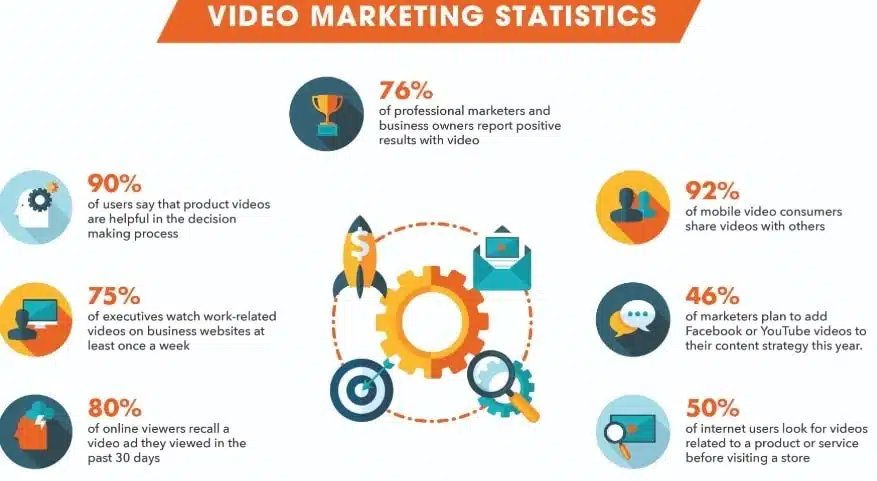In the rapidly evolving landscape of SaaS content marketing, utilizing video has become a paramount strategy for capturing the attention of audiences and conveying complex concepts in an engaging manner. As the demand for SaaS solutions continues to soar, crafting an effective video marketing strategy tailored to your target audience is essential.
Choosing the Right Style of Video for SaaS Content Marketing
In the rapidly evolving landscape of SaaS content marketing, utilizing video has become a paramount strategy for capturing the attention of audiences and conveying complex concepts in an engaging manner. As the demand for SaaS solutions continues to soar, crafting an effective video marketing strategy tailored to your target audience is essential.
Understanding Your Audience
The foundation of any successful SaaS content marketing campaign, including video, is a deep understanding of your target audience. Who are they? What challenges do they face? What motivates them to seek a SaaS solution? The answers to these questions will guide your choice of video style. A B2B audience might respond well to informative explainer videos, while a B2C audience could be more drawn to emotional and relatable storytelling.

1. Explainer Videos:
Explainer videos are a staple in SaaS content marketing. These concise, visually appealing videos elucidate the value of your SaaS product or solution in a straightforward manner. By breaking down complex concepts into easy-to-digest visuals, explainer videos showcase how your SaaS offering can solve specific pain points. They often incorporate animations, infographics, and voiceovers to simplify intricate details.
2. Customer Testimonials:
Leveraging the experiences of satisfied customers can greatly influence prospects in their decision-making process. Customer testimonial videos add a human touch to your SaaS content marketing efforts, offering real-life success stories that resonate with potential users. Authenticity is key here – genuine emotions and relatable narratives can build trust and credibility around your SaaS solution.
3. Product Demos:
For SaaS solutions, where the features and functionality might not be immediately evident, product demo videos play a crucial role. These videos walk viewers through the software’s interface, highlighting key features and benefits. A well-executed product demo can effectively showcase the user experience and demonstrate how your SaaS product can simplify tasks and improve efficiency.
4. Thought Leadership and Educational Content:
Positioning your brand as an industry thought leader can set you apart in the competitive SaaS landscape. Educational videos that delve into industry trends, best practices, and insightful tips can establish your authority and attract an audience seeking valuable insights. These videos should focus on providing actionable knowledge rather than overtly promoting your product.
5. Animated Infographics:
Infographics are visually engaging, and when animated, they can become even more captivating. Animated infographics can effectively present data, statistics, and complex processes in an easily digestible format. These videos are particularly useful when you need to convey a lot of information without overwhelming the viewer.
Crafting an impactful SaaS content marketing strategy involves choosing the right style of video to convey your message. By understanding your audience and aligning your video style with their preferences and needs, you can create content that resonates and drives engagement. Whether through explainer videos, customer testimonials, product demos, thought leadership content, or animated infographics, each style has its own unique strengths. By strategically combining these styles based on your marketing goals, you can create a well-rounded video marketing strategy that effectively promotes your SaaS solution and reaches your target audience in a meaningful way.
The key lies in consistently producing high-quality videos that provide value and foster a connection with your audience, ultimately driving SaaS adoption and business growth.
Mapping Out Objectives for Planning a SaaS Marketing Video
Creating an effective SaaS marketing video requires more than just a compelling storyline and stunning visuals. To ensure your video serves its purpose and aligns with your broader marketing strategy, a clear set of objectives must be mapped out.

1. Lean on Your Target Audience:
Before outlining objectives, it’s crucial to identify your target audience. Who are they? What challenges do they face? What solutions are they seeking? Understanding your audience’s demographics, preferences, and pain points will enable you to tailor your video’s objectives to address their specific needs.
2. Raise Brand Awareness:
One of the primary objectives for SaaS marketing videos is to enhance brand visibility. By introducing your SaaS solution in an engaging and memorable way, you can increase brand recognition within your target market. Incorporate your brand’s unique value proposition and messaging to leave a lasting impression on viewers.
3. Educate and Inform:
Many potential customers might not fully comprehend the intricacies of your SaaS product. Use videos as a tool to educate and inform your audience about how your solution works and how it can solve their problems. Whether through explainer videos or product demos, the objective is to simplify complex information and make it accessible.
4. Showcase Unique Selling Points:
Highlight the features and benefits that set your SaaS product apart from the competition. By showcasing your unique selling points, you can position your solution as the go-to choice for addressing specific pain points. Craft your objectives around presenting these differentiators clearly and effectively.
5. Generate Leads and Conversions:
A well-executed SaaS marketing video can be a powerful lead generation tool. Include clear calls-to-action (CTAs) that guide viewers to take specific actions, such as signing up for a free trial, subscribing to your newsletter, or visiting your tech websites. Design your video’s objectives to drive these desired actions and ultimately convert viewers into leads.
6. Establish Thought Leadership:
B2B brand positioning includes ensuring you are seen as a thought leader in the SaaS industry and requires sharing insightful and valuable content. Use videos as a platform to provide expert advice, industry insights, and actionable tips. Your objectives should center around offering meaningful content that establishes your authority and fosters trust with your audience.
7. Tell Compelling Stories:
Humans are wired to connect with stories on an emotional level. Incorporate storytelling into your video objectives to create a deeper connection with your audience. Whether through customer testimonials or narratives that resonate, aim to evoke emotions that strengthen the viewer’s bond with your brand.
8. Drive User Engagement:
Engagement is a key metric in assessing the effectiveness of your SaaS marketing video. Set objectives that encourage viewers to like, comment, share, and interact with your video content. Increased engagement not only expands your reach but also indicates that your content resonates with the audience.
9. Measure and Analyze:
Your video’s objectives should include a plan for measuring success. Utilize analytics tools to track metrics such as views, click-through rates, conversion rates, and engagement levels. Regularly analyze these metrics to determine if your video is meeting its intended objectives and make adjustments as needed.
By aligning your video’s goals with your overall marketing strategy and considering factors like target audience, brand awareness, education, lead generation, and engagement, you can create a video that not only captivates viewers but also drives tangible results. Objectives provide a roadmap for your video’s creation, ensuring that every element – from the script to the visuals – is carefully crafted to achieve your desired outcomes in the competitive landscape of SaaS content marketing.
Storyboarding for SaaS Marketing Videos
Bringing Your Message to Life
In the realm of SaaS video marketing, where attention spans are short and competition is fierce, the art of storytelling through visuals has taken center stage. A well-crafted video can communicate the essence of your SaaS product, engaging and resonating with your target audience. This is where storyboarding comes into play – a crucial step in the video production process that transforms ideas into a visual narrative.

Understanding Storyboarding:
Storyboarding is the process of visually planning a video from start to finish. It involves creating a sequence of drawings or illustrations that outline each scene’s composition, camera angles, character movements, and accompanying dialogue or narration. A well-structured storyboard serves as a blueprint for your SaaS marketing video, ensuring a cohesive and compelling narrative.
Mapping Your Message:
Effective SaaS marketing videos must convey a clear and concise message. The storyboard acts as a canvas to map out how this message unfolds visually. Begin by identifying the key points you want to communicate – the unique features of your SaaS product, the problems it solves, and the benefits it offers. Each of these points becomes a scene in your storyboard, allowing you to visualize the flow of information.
Highlighting Pain Points and Solutions:
A fundamental aspect of SaaS video marketing is addressing pain points and presenting solutions. Your storyboard should illustrate these scenarios, showing how your SaaS product alleviates the challenges your target audience faces. By visually depicting the “before” and “after” states, you can effectively communicate the transformation your product brings.
Creating Visual Engagement:
Incorporate visual elements that capture attention and maintain engagement. Whether it’s captivating animations, vibrant graphics, or dynamic camera movements, your storyboard should depict how these visual components will enhance your video’s impact. Each scene’s composition and transitions play a vital role in guiding the viewer’s focus.
Storyboarding for User Experience:
User experience is at the heart of SaaS products, and your marketing video should reflect this. Use your storyboard to map out the user journey within the video. Showcase how intuitive your SaaS solution is by depicting seamless interactions and straightforward processes. This user-centric approach resonates with potential customers, driving interest and conversion.
Narrative Flow and Emotion:
A compelling SaaS video engages both the mind and the heart. Your storyboard should consider the emotional journey your audience will experience. Craft scenes that evoke emotions relevant to the content – whether it’s excitement about a feature, relief from a pain point, or confidence in your solution. Balancing information with emotion keeps viewers invested.
Storyboard Collaboration:
Storyboarding is often a collaborative process involving multiple stakeholders, including scriptwriters, designers, and animators. By sharing the storyboard, you align everyone’s vision and ensure that the final video meets your SaaS video marketing objectives. Feedback and adjustments can be made before production, saving time and resources.
Optimizing for Conversion:
Ultimately, the goal of your SaaS marketing video is to drive conversion. Your storyboard should emphasize conversion-oriented elements, such as clear calls-to-action (CTAs) that guide viewers on the desired path – whether it’s signing up for a trial, requesting a demo, or subscribing to your service.
Iterating for Perfection:
Storyboarding isn’t a one-shot endeavor; it’s a process of refinement. As you review the initial storyboard, consider how each scene aligns with your marketing objectives and message. Iterate to enhance the narrative flow, visual aesthetics, and alignment with your SaaS brand.
By mapping out scenes that highlight pain points, solutions, user experience, emotions, and conversion elements, your storyboard becomes a powerful tool in crafting an impactful video. It guides the production process, fosters collaboration, and ensures that your SaaS video marketing efforts result in a video that resonates with your audience and drives desired outcomes.
Written by: Tony Zayas, Chief Revenue Officer
In my role as Chief Revenue Officer at Insivia, I am at the forefront of driving transformation and results for SaaS and technology companies. I lead strategic marketing and business development initiatives, helping businesses overcome plateaus and achieve significant growth. My journey has led me to collaborate with leading businesses and apply my knowledge to revolutionize industries.
